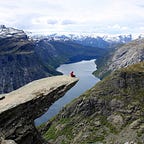Greek Odyssey — 6
Heraklion’s Hero
Theseus, son of King Aegeus of Athens sailed with six other boys and seven girls from Athens to Crete in order to fulfil a deal made to keep peace with the island’s King Minos who had earlier lost his son to Athens. When they arrived in the island of Crete, the young prince was awestruck by the beauty of Princess Ariadne. He was to be sent to the Minotaur, the terrifying bull with a man’s body along with the other Athenians so he did not get to spend much time with the lovely princess, however the little time they got together would save his life.
Daedalus, the creator of a labyrinth that housed the Minotaur, had given away a few secrets to Ariadne, which she willingly shared with Theseus on the condition that she could accompany him after his triumph. Following her instructions, he entered the maze with a sword and ball of string tying one end to the door. Leaving the others there, he walked straight to the centre, never leaving the other end of the string and found the slumbering beast. The Minotaur woke up and a raging battle ensued with Theseus ultimately plunging the sword into the monster’s throat.
The victorious prince followed the string back to the entrance and as promised, took the princess with him. After resting on a beach in Naxos for some time Theseus was instructed by Athena to leave the sleeping princess behind to Dionysus and sail away. His father awaited him near Athens looking for the white sail he was to unfurl announcing his success.
Distraught over the loss of Ariadne, Theseus neglected to put the sail up and Aegeus, noticing the ship without the sail could not suppress his sorrow. He threw himself off a cliff into a sea that would later bear his name.
This well-known tale of Greek mythology took place in Knossos, a short bus ride away from Heraklion. The site consists of a half built palace with giant amphorae called pithoi and Minoan frescoes, including a replica of the impressive Taureador or Leaping Bull, the Prince of Lilies, griffins and dolphins from the great civilisation that flourished around 3,000 BCE. The Palace of Minos was excavated and partly rebuilt by British archaeologist Sir Arthur Evans. He restored many of the frescoes and named some of the rooms like the “Throne room” but the authenticity of his work is questioned. It takes an hour or two to tour the site in its verdant setting.
The city of Heraklion
The city of Heraklion is the capital of Crete and is Greece’s fourth city. It is recognisable by its Venetian port, the 16th century Rocca al Mare fortress and arched buildings of the harbour. Walking away from the sea along a sloping road leads to the Saint Titus basilica, which was once the Ottoman Vezir mosque. The square near this religious building is filled with restaurants, cafés and of course, the omnipresent gyros stalls selling that delicious Greek kebab roll slathered in tzatziki. This university town also has an archaeological museum housing various Minoan artefacts.
Between Heraklion and Chania are splendid beaches that you can have all to yourself in springtime. Another city worth visiting between these two points is Rethymno. It is dominated by the Fortezza citadel that protectively watches over it. This citadel is close the quaint old city with the remains of Rimondi fountain. The streets are filled with souvenir shops and it is evident that the tourist is king here. The small Venetian harbour is not without charm. This area deserves two or three days to explore the nature, monuments and history.
Getting to Crete
There are several ferries from the port of Piraeus in Athens that go to Crete and the trip takes around 9 hours. To get there faster, Aegean Air and Olympic Air operate flights between Athens and Heraklion.
Low cost companies like EasyJet fly there from other European cities.
There are buses to get around Crete but renting a car or a scooter means not depending on bus timings and more freedom and flexibility.
Hi, I am Prajwal Madhav. I hope you enjoy my posts.
